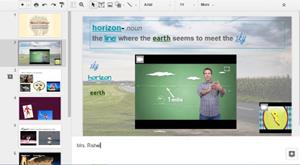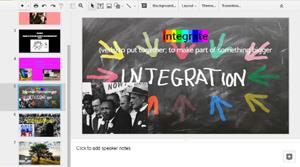 After the 2005 publication of the National Reading Panel report, there has been a sense of urgency to accelerate student acquisition of academic vocabulary to support comprehension. We learned that “teaching words well means giving students multiple opportunities to develop word meanings and learn how words are conceptually related to one another in the texts they are studying” (Vacca & Vacca, 2016). Yet the vocabulary results from the 2009 and 2011 NAEP reading assessments demonstrate that “fourth- and eighth-grade vocabulary scores did not change significantly from 2009 to 2011.” If “vocabulary is the glue that holds stories, ideas and content together...making comprehension accessible for children” (Rupley, Logan & Nichols, 1998/99), then maybe our current strategies alone aren’t making vocabulary stick.
After the 2005 publication of the National Reading Panel report, there has been a sense of urgency to accelerate student acquisition of academic vocabulary to support comprehension. We learned that “teaching words well means giving students multiple opportunities to develop word meanings and learn how words are conceptually related to one another in the texts they are studying” (Vacca & Vacca, 2016). Yet the vocabulary results from the 2009 and 2011 NAEP reading assessments demonstrate that “fourth- and eighth-grade vocabulary scores did not change significantly from 2009 to 2011.” If “vocabulary is the glue that holds stories, ideas and content together...making comprehension accessible for children” (Rupley, Logan & Nichols, 1998/99), then maybe our current strategies alone aren’t making vocabulary stick.
Technology provides new ways for students to interact with information through multimodal learning opportunities. My colleague Kathy Krepps commented on how her students didn’t know what the dictionary was, and I realized that text is not the first resource our students access to seek information. Our third-, fourth-, and fifth-grade students who have one-to-one Chromebook classrooms naturally say “OK Google” to find information, not to read but to watch and to listen.
During this school year, Kathy and I have been working with teachers and students to develop our own elementary ELA curriculum. By using Google Slides, third-grade students create digital word collages, and fifth-grade students create a digital vocabulary notebooks as part of our vocabulary instruction. These tasks became easily differentiated for students with autism, who needed more nonverbal representations; for gifted and high-achieving students, who wanted to create new ways to represent meaning of higher academic vocabulary; and for struggling readers, who needed the repetition and guidance. In the following examples, you can see how students make meaningful connections to words through multimedia.
Digital word collages

Third-grade students used a digital word collage to explore ways to connect to unknown words from a text read in a literature circle. One student began adding symbols and songs, and the comment feature allowed me to guide his thinking through questioning.

Another student used an image as a background and used the color and the font of the words to help show the word’s meaning. Two videos show multiple meanings of how a word is used in earth science and poetically in a song.

Digital literacy notebooks

Fifth-grade students created and presented teacher- or self-selected words for a given unit in digital vocabulary notebooks. Then they engaged in academic conversations to discuss why the images, videos, and fonts were chosen and if they agree or disagree with perspectives. Word generation vocabulary units make it easy to incorporate this strategy into current events or to help students make personal connections.


Digital word collages and digital vocabulary notebooks are only two examples of how Google Slides can engage students in the instruction of academic vocabulary.
Other classrooms have been inspired to find additional ways to use Google Slides for vocabulary instruction. Andrew Pry, a fourth-grade teacher, challenges his students to use a “bank” in Google Slides to share “great vocabulary” words they come across inside and outside of class.
The multiple opportunities that students need to accelerate vocabulary acquisition exists in what they read and write but also in what we listen, speak, and view. Adding strategies like this can be the glue needed to make vocabulary stick.
 Meg Rishel is an Instructional ELA Coach for Eastern York School District. You can follow her on Twitter.
Meg Rishel is an Instructional ELA Coach for Eastern York School District. You can follow her on Twitter.
This article is part of a series from the International Literacy Association’s Technology in Literacy Education Special Interest Group (TILE-SIG).